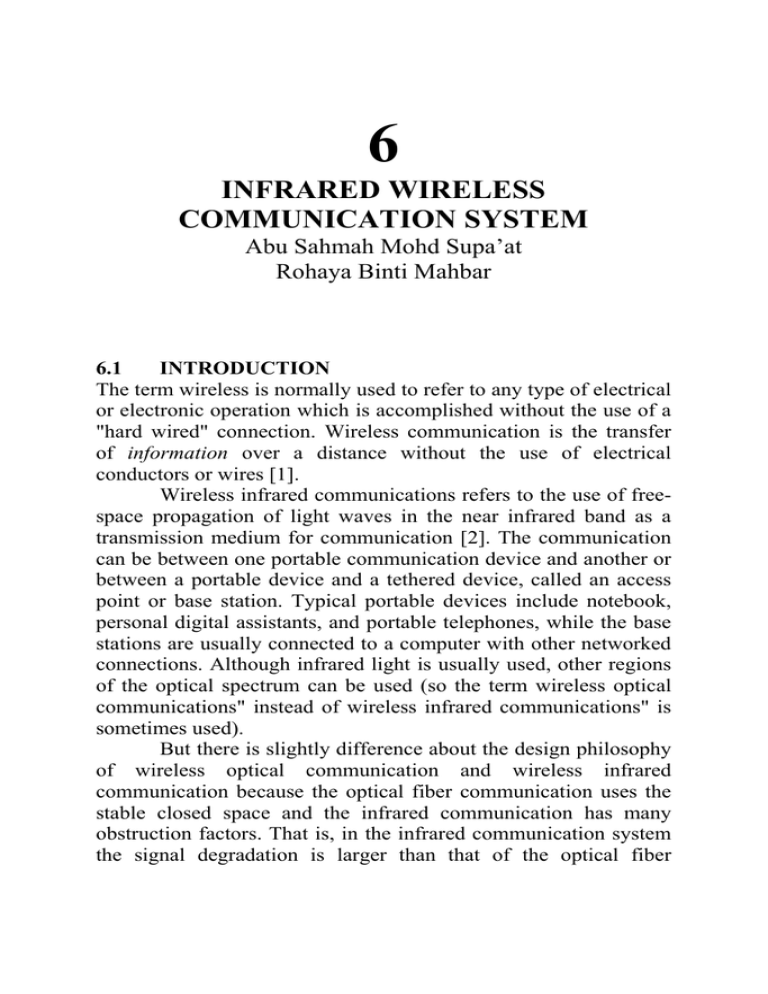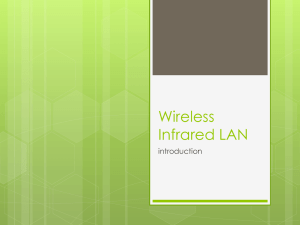6 INFRARED WIRELESS COMMUNICATION SYSTEM Abu Sahmah Mohd Supa’at
advertisement

6
INFRARED WIRELESS
COMMUNICATION SYSTEM
Abu Sahmah Mohd Supa’at
Rohaya Binti Mahbar
6.1
INTRODUCTION
The term wireless is normally used to refer to any type of electrical
or electronic operation which is accomplished without the use of a
"hard wired" connection. Wireless communication is the transfer
of information over a distance without the use of electrical
conductors or wires [1].
Wireless infrared communications refers to the use of freespace propagation of light waves in the near infrared band as a
transmission medium for communication [2]. The communication
can be between one portable communication device and another or
between a portable device and a tethered device, called an access
point or base station. Typical portable devices include notebook,
personal digital assistants, and portable telephones, while the base
stations are usually connected to a computer with other networked
connections. Although infrared light is usually used, other regions
of the optical spectrum can be used (so the term wireless optical
communications" instead of wireless infrared communications" is
sometimes used).
But there is slightly difference about the design philosophy
of wireless optical communication and wireless infrared
communication because the optical fiber communication uses the
stable closed space and the infrared communication has many
obstruction factors. That is, in the infrared communication system
the signal degradation is larger than that of the optical fiber
64
Wireless Communication Technology in Malaysia
communication, and the degradation is much deviated by the
meteorological condition while the degradation is calculated using
the cable length in the optical fiber communication. Consequently
the infrared communication system must include the large system
margin against the deviation of the signal quality.
In the infrared communication system the signal quality,
that is the system availability, is affected by the meteorological
condition and remarkably affected by the regional difference. The
infrared communication system uses many technical solutions in
order to provide the stable transmission path against these
environmental conditions.
Anyone who has used an infrared remote control is familiar
with some of the limitations of optical systems. The range tends to
be short, the signal will not pass through walls or other opaque
objects, and usually the transmitter must be carefully pointed in the
direction of the receiver. A short-range infrared system called
Infrared Data Association (IrDA) has been used for some time to
allow two devices to communicate with each other [3].
A typical example would be the synchronization of data
between a desktop and a notebook computer. The system is
deliberately restricted to a range of one meter to allow several
independent infrared links to operate simultaneously in the same
room. LEDs operating at a wavelength of about 860 nm are used.
Several data rates are specified, up to a maximum of 4 Mb/s, but
most systems operate at a significantly lower data rate, since it is
common to connect an infrared transceiver to the serial port on
computers without built-in infrared ports [4].
6.1.1 Applications
The primary commercial applications are as follows: Short-term
cable-less connectivity for information exchange (business cards,
schedules, file sharing) between two users. Wireless local area
networks (WLANs) provide network connectivity inside buildings.
This can either be an extension of existing LANs to facilitate
mobility, or to establish “ad hoc" networks where there is no LAN
(Local Area Network). Building-to-building connections for high-
Infrared Wireless Communication System
65
speed network access or metropolitan- or campus-area networks.
Wireless input and control devices, such as wireless mice, remote
controls, wireless game controllers, and remote electronic keys.
6.1.2 Link Type
Another important way to characterize a wireless infrared
communication system is by the “link type", which means the
typical or required arrangement of receiver and transmitter. Figure
2 depicts the two most common configurations: the point-to-point
system and the diffuse system.
The simplest link type is the point-to-point system. There,
the transmitter and receiver must be pointed at each other to
establish a link. The line-of-sight (LOS) path from the transmitter
to the receiver must be clear of obstructions, and most of the
transmitted light is directed toward the receiver. Hence, point-topoint systems are also called directed LOS systems. The links can
be temporarily created for a data exchange session between two
users, or established more permanently by aiming a mobile unit at
a base station unit in the LAN replacement application.
In diffuse systems, the link is always maintained between any
transmitter and any receiver in the same vicinity by reflecting or
“bouncing" the transmitted information-bearing light or reflecting
surfaces such as ceilings, walls, and furniture. This allows the
computers to be moved around, but they must in the same room
[3]. Here, the transmitter and receiver are non-directed; the
transmitter employs a wide transmit beam and the receiver has a
wide field-of-view. Also, the LOS path is not required. Hence,
diffuse systems are also called non directed non-LOS systems.
These systems are well suited to the wireless LAN application,
freeing the user from knowing and aligning with the locations of
the other communicating devices.
6.2
OPTICAL DESIGN
6.2.1 Modulation and demodulation
Most communication systems are based on phase, amplitude, or
frequency modulation, or combination of these techniques.
66
Wireless Communication Technology in Malaysia
However, it is difficult to detect such a signal following nondirected propagation, and more expensive narrow-linewidth
sources are required [5]. An effective solution is to use intensity
modulation, where the transmitted signal's intensity or power is
proportional to the modulating signal.
At the demodulator (usually referred to as a detector in
optical systems) the modulation can be extracted by mixing the
received signal with a carrier light wave. This coherent detection
technique is best when the signal phase can be maintained.
However this can be difficult to implement and additionally, in
non-directed propagation, it is difficult to achieve the required
mixing efficiency. Instead, one can use direct detection using a
photo detector. The photo detector current is proportional to the
received optical signal intensity, which for intensity modulation, is
also the original modulating signal. Hence, most systems use
intensity modulation with direct detection (IM/DD) to achieve
optical modulation and demodulation.
In a free-space optical communication system, the detector
is illuminated by sources of light energy other than the source.
These can include ambient lighting sources, such as natural
sunlight, fluorescent lamp light, and incandescent lamp light.
These sources cause variation in the received photocurrent that is
unrelated to the transmitted signal, resulting in an additive noise
component at the receiver. We can write the photocurrent at the
receiver as
Y (t) = X(t) - Rh(t) + N(t) (1)
R in “(1)” is the responsivity of the receiving photodiode (A/W).
Note that the electrical impulse response c(t) is simply R times the
optical impulse response h(t).
6.2.2 Receivers and Transmitters
A transmitter or source converts an electrical signal to an optical
signal. The two most appropriate types of device are the lightemitting diode (LED) and semiconductor laser diode (LD). LEDs
have a naturally wide transmission pattern, and so are suited to non
directed links. Eye safety is much simpler to achieve for an LED
Infrared Wireless Communication System
67
than for a laser diode, which usually have very narrow transmit
beams.
The principal advantages of laser diodes are their high
energy-conversion efficiency, their high modulation bandwidth
and their relatively narrow spectral width. Although laser diodes
offer several advantages over LEDs that could be exploited, most
short-range commercial systems currently use LEDs.
A receiver or detector converts optical power into electrical
current by detecting the photon flux incident on the detector
surface. Silicon p-i-n photodiodes are ideal for wireless infrared
communications as they have good quantum efficiency in this band
and are inexpensive [6]. Avalanche photodiodes are not used here
since the dominant noise source is background light-induced shot
noise rather than thermal circuit noise.
6.2.3 Transmission Wavelength and Noise
The most important factor to consider when choosing a
transmission wavelength is the availability of effective, low-cost
sources and detectors. The availability of LEDs and silicon
photodiodes operating in the 800 nm to 1000 nm range is the
primary reason for the use of this band [4]. Another important
consideration is the spectral distribution of the dominant noise
source: background lighting.
The noise N(t) can be broken into four components: photon
noise or shot noise, gain noise, receiver circuit or thermal noise,
and periodic noise. Gain noise is only present in avalanche-type
devices. Photon noise is the result of the discreteness of photon
arrivals. It is due to background light sources, such as sun light,
fluorescent lamp light, and incandescent lamp light, as well as the
signal-dependent source X(t) - c(t). Since the background light
striking the photo detector is normally much stronger than the
signal light, we can neglect the dependency of N(t) on X(t) and
consider the photon noise to be additive white Gaussian noise with
two-sided power spectral density S(f) = qRPn where q is the
electron charge, R is the responsivity, and Pn is the optical power
of the noise (background light).
68
Wireless Communication Technology in Malaysia
Receiver noise is due to thermal effects in the receiver
circuitry, and is particularly dependent on the type of preamplifier
used. With careful circuit design, it can be made insignificant
relative to the photon noise [7].
Periodic noise is the result of the variation of fluorescent
lighting due to the method of driving the lamp using the ballast.
This generates an extraneous periodic signal with a fundamental
frequency of 44 kHz with significant harmonics to several MHz
[4]. Mitigating the effect of periodic noise can be done using highpass filtering in combination with baseline restoration [8], or by
careful selection of the modulation type.
6.2.4 Safety
There are two safety concerns when dealing with infrared
communication systems. Eye safety is a concern because of a
combination of two effects: the cornea is transparent from the near
violet to the near infrared. Hence, the retina is sensitive to damage
from light sources transmitting in these bands. However, the near
infrared is outside the visible range of light, and so the eye does
not protect itself from damage by closing the iris or closing the
eyelid. Eye safety can be ensured by restricting the transmit beam
strength according to IEC or ANSI standards [9, 10].
Skin safety is also a possible concern. Possible short-term
effects such as heating of the skin are accounted for by eye safety
regulations (since the eye requires lower power levels than the
skin). Long-term exposure to infrared light is not a concern, as the
ambient light sources are constantly submitting our bodies to much
higher radiation levels than these communication systems do.
6.3
STANDARDS AND SYSTEMS
We examine the details of the two dominant wireless infrared
technologies, IrDA and IEEE 802.11, and other commercial
applications.
Infrared Wireless Communication System
69
6.3.1 Infrared Data Association Standards (IrDA)
The Infrared Data Association, an association of about one
hundred member companies, has standardized low-cost optical
data links [11]. The IrDA link transceivers or “ports”, appear on
many portable devices including notebook computers, personal
digital assistants, and also computer peripherals such as printers.
The series of IrDA transmission standards are described in
Table 2. The current version of the physical layer standards is
IrPHY 1.3. Data rates from 2.4 kb/s to 4 Mb/s are supported. The
link speed is negotiated by starting at 9.6 kb/s. Most of the
transmission standards are for short-range, directed links which an
operating range from 0 m to 1 m. The transmitter half angle must
be between 15 and 30 degrees, and the receiver field-of-view half
angle must be at least 15 degrees. The transmitter must have a
peak-power wavelength between 850 nm and 900 nm [4].
6.3.2 IEEE 802.11 and wireless LANs
The IEEE has published a set of standards for wireless LANs,
IEEE 802.11 [12]. The IEEE 802.11 standard is designed to fit into
the structure of the suite of 802 LAN standards. Hence, it
determines the physical layer (PHY) and medium-access control
layer (MAC) leaving the logical-link control (LLC) to 802.2. The
MAC layer uses a form of carrier-sense multiple access with
collision avoidance (CSMA/CA).
The original standard supports both radio and optical
physical layers with a maximum data rate of 2 Mb/s. The 802.11b
standard adds a 2.4 GHz radio physical layer at up to 11 Mb/s and
802.11a standard adds a 5.4 GHz radio physical layer at up to 54
Mb/s.
The two supported data rates for infrared 802.11
LANs are 1 Mb/s and 2 Mb/s. Both systems use PPM but
share a common chip rate of 4 Mchips/s, as explained below. Each
frame begins with a preamble encoded using 4 Mb/s OOK. In the
preamble, a three-bit field indicates the transmission type, either 1
Mb/s or 2 Mb/s (the six other types are reserved for future use).
The data is then transmitted at 1Mb/s using 16-PPM or 2 Mb/s
70
Wireless Communication Technology in Malaysia
using 4-PPM. 16-PPM carries log 2(16)=16=1/4 bits/chip, and 4PPM carries log2(4)=4 = 1=2 bits/chip, resulting in the same chip
time for both types. The transmitter must have a peak-power
wavelength between 850 nm and 950 nm. The required transmitter
and receiver characteristics are intended to allow for reliable
operation at link lengths up to10 m [4].
6.3.3 Building-to-building systems
Long range (greater than 10 m) infrared links must be directed
LOS systems in order to ensure a reasonable path loss. The
emerging products for long- range links are typically designed to
be placed on rooftops [13,14], as this provides the best chance for
establishing line-of-sight paths from one location to another in an
urban environment. These high data rate connections can then be
used for enterprise net-work access or metropolitan- or campusarea net-works.
There are several design issues specific to these systems
that are unique to these long-range systems [15]. The first is
atmospheric path loss, which is a combination of clean-air
absorption from the air and absorption and scattering from
particles in the air, such as rain, fog, and pollutants. Secondly, an
effect called scintillation, which is caused by temperature
variations along the LOS path, causes rapid fluctuations in the
channel quality. Finally, building sway can affect alignment and
result in signal loss unless the transceivers are mechanically
isolated or active alignment compensation is used.
6.3.4 Other Applications
Wireless infrared communication has found several markets in and
around the home, car, and office which fall outside the traditional
telecommunications markets of voice and data networking. These
can either be classified as wireless input devices, or as wireless
control devices, depending on one's perspective. Examples include
wireless computer mice and keyboards, remote controls for
entertainment equipment, wireless video-game controllers, and
wireless door keys for home or vehicle access. All such devices
Infrared Wireless Communication System
71
use infrared communication systems due to the attractive
combination of low cost, reliability, and light weight in a
transmitter/receiver pair that achieves the required range, data rate,
and data integrity required
6.4
CONCLUSIONS
Wireless infrared communication systems provide a useful
complement to radio-based systems, particularly for systems
requiring low cost, light weight, moderate data rates, and only
requiring short ranges.
When LOS paths can be assured, range can be dramatically
improved to provide longer links. Infrared systems have already
proven their effectiveness for short-range temporary
communications and in high data rate longer range point-to-point
systems
TABLE 6.1 Infrared Versus Other Communication Method
Signal
Cable
electrical signal
optical signal
Wireless
electromagnetic
wave
radio
(≤3THz)
infrared
beam
Media
copper
cable
optical fiber
cable
air (license)
air (no
constraints)
72
Wireless Communication Technology in Malaysia
TABLE 6.2
IRDA Data Transmission
Version
Link
Type
Link
Range
Data Rate
Modulation
1.3
Pointto-point
1m
2.4-115.2 kb/s
RZ-3/16
1.3
Pointto-point
1m
576 kb/s
1152 kb/s
RZ-1/4
RZ-1/4
1.3
Pointto-point
1m
4 Mb/s
4- PPM
VFIR/1.4
Pointto-point
1m
16Mb/s
OOK
Air/proposed
Network
4,8m
4Mb/s
250kb/s
REFERENCES
[1]
[2]
[3]
[5]
[6]
[7]
[8]
http://en.wikipedia.org/wiki/Wireless"
nd
Roy Blake, Electronic Communication System, 2 ed
Niagara College of Applied Arts & Technology Welland,
Ontorio, Canada, pp 865-873
Jefrey B. Carruthers, Wireless Infrared Communication.
Boston University, Boston, MA 02215 USA.
J. M. Kahn and J. R. Barry, “Wireless infrared
communications,” Proceedings of the IEEE, vol. 85, pp.
265{98, Feb. 1997}
J. R. Barry, Wireless Infrared Communications. Boston:
Kluwer Academic Publishers, 1994.
J. R. Barry and J. M. Kahn, “Link design for non-directed
wireless infrared communications,” Applied Optics, vol. 34,
pp. 3764{3776, July 1995.
R. Narasimhan, M. D. Audeh, and J. M. Kahn, “Effect of
electronic-ballast fluorescent lighting on wireless infrared
Infrared Wireless Communication System
73
links," IEE Proceedings-Optoelectronics, vol. 143, pp. 347354, Dec. 1996.
[9]
International Electrotechnical Commission, CEI/IEC825-1:
Safety of Laser Products, 1993.
[10] ANSI-Z136-1, American National Standard for the Safe
Use of Lasers, 1993.
[11] http://www.irda.gov.
[12] IEEE Std 802.11-1999 Wireless LAN Medium Access
Control (MAC) and Physical Layer (PHY) specifications.
[13] http://www.canobeam.com.
[14] http://www.terabeam.com.
[15]
D. Heatley, D. Wisely, I. Neild, and P. Cochrane, “Optical
wireless: The story so far,” IEEE Communications
Magazine, pp. 72{82, Dec. 1998.




